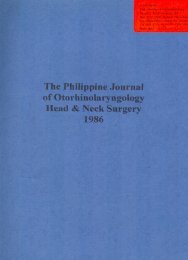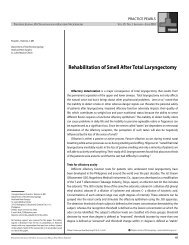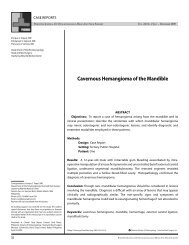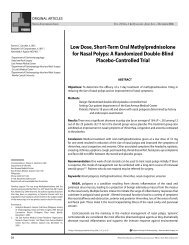You also want an ePaper? Increase the reach of your titles
YUMPU automatically turns print PDFs into web optimized ePapers that Google loves.
UNIVERSITY<br />
PHILIPPINE<br />
DEPARTMENT<br />
OF THE PHILIPPINES<br />
GENERAL HOSPITAL<br />
OF OTOLARYNGOLOGY<br />
TITLE:MICROBIALFLORAIN CHRONICOTITISMEDIA:VALUEOFEARASPIRATE<br />
CULTURESTUDIES<br />
AUTHORS:Rhodoradel Rosario,MD<br />
CharlotteM. Chiong,MD<br />
AbnerL. Chan,MD<br />
EditaC. Yap, MD<br />
JoselitoC. Jamir,MD<br />
GenerosoT. Abes,MD<br />
ABSTRACT A comparative study was done to compare the<br />
, microbiology of the ear aspirate to the contents in the<br />
Culture and sensitivity studies on ear aspirate, middle ear cleft namely, cholesteatoma, bone and<br />
cholesteatoma, bone and granulation tissue were granulation tissue. The organisms were likewise<br />
done on 30 patients with chronic otitis media who identified andthe sensitivity pattern of the commonly<br />
underwent radical mastoidectomy. The most com- isolated organisms were determined.<br />
mon organisms isolated were Proteus mirabilis,Proteus<br />
vulgaris and Pseudomonas aeruginosa. All three<br />
showed a 100% sensitivity to ampicillin, trimethoprim, MATERIALS AND METHODS<br />
chloramphenicol and cephalexin, Bacteroides, an<br />
anaerobic organisms, was grown in only 4/100 Thirty patients with chronic otitis media, 20 males<br />
isolates. Cultures from the transcanal aspirates were and ten females with age range 6-45 years (Table 1)<br />
compared to those obtained directly from the middle seen at the ENT Dept. who underwent radical masear.<br />
Computation of the positive predictive value toidectomy were included in the study. Culture<br />
showed that the transcanal aspirate showed a good and sensitivity studies were done on ear aspirate,<br />
excellent correlation for the three most common cholesteatoma, bone and granulation tissue specimens.<br />
organisms cultured. Ear discharge was aspirated aseptically after the ear<br />
canal was swabbed with aloohol soaked cotton. The<br />
INTRODUCTION other specimens were collected intraoperatively. All<br />
_<br />
were immediately placed in thioglycolate media. These<br />
Chronic otitis media (COM) is a common problem were then inoculated in blood agar plate (BAP), and<br />
encountered in the ENT clinic. It is an insidious Mac Conkey agar plate. Incubation at 37 C for 24<br />
and potentially destructive disease characterized by hours was done after which the plates were read.<br />
the presence of intractable mucosal, submucosal and/ Colonies were identified by their morphologic and<br />
or bone pathology of the middle cleft. In this biochemical characteristics. Antibiotic susceptabilinstitution,<br />
60% of 269 ears operated on during the ity of the aerobic isolates to various drugs were<br />
year 1989 were for chronically discharging ears. Inspite tested using standard Kirby-Bauer method. For the<br />
of the prevalence of the disease, antibiotic treatment anaerobic culture, the specimen from the thioglycote<br />
is still largely empirical as a culture and sensitivity medium were inoculated in a fresh blood agar plate<br />
studies are not routinely done. One method of under gas Pak method. If the isolates were the same<br />
obtaining specimen for culture in the clinic is by as those found in the aerobic culture, no further<br />
transcanal aspiration of ear discharge. However, it susceptibility studies were done. However if the<br />
is yet to be determined whether this method would colonies identified were the same as those found in<br />
be truly reflective of the microbial population of the aerobic culture, no further susceptibility studies<br />
middle ear. were done. However if the colonies identified were<br />
58
















